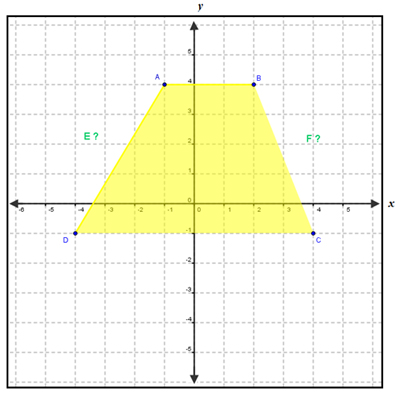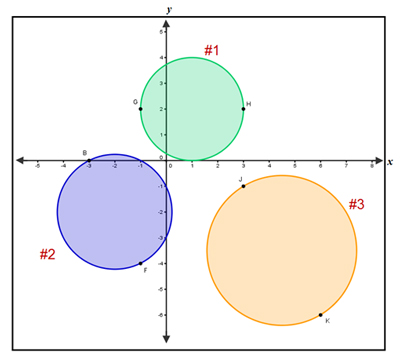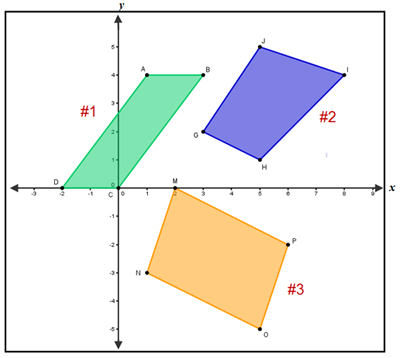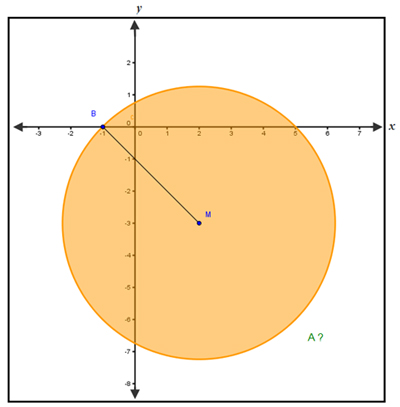Now that you understand the midpoint formula and how it works, practice some problems where you might need it.
- The midsegment of a trapezoid is formed by connecting the midpoints of the non-parallel sides. Determine the coordinates of the endpoints that would form the midsegment of trapezoid ABCD.

Click on the blanks to check your answers.
E
Interactive button. Assistance may be required.
__________
(-2.5, 1.5)
F
Interactive button. Assistance may be required.
__________
(3, 1.5)
- The diameter of circles has a midpoint at the center of the circle. Use the graph below to find the center or each circle.

Click on the blanks to check your answers.
Center of Circle 1
Interactive button. Assistance may be required.
__________
(1, 2)
Center of Circle 2
Interactive button. Assistance may be required.
__________
(-2, -2)
Center of Circle 3
Interactive button. Assistance may be required.
__________
(4.5, -3.5)
- A segment is bisected into two equal parts at its midpoint and a polygon is a parallelogram if its diagonals bisect each other.
Based on this information determine if the polygons below are parallelograms.

Click on the blanks to check your answers.
Polygon #1
Midpoint AC
Interactive button. Assistance may be required.
__________
(0.5, 2)
Midpoint BD
Interactive button. Assistance may be required.
__________
(0.5, 2)
Parallelogram?
Interactive button. Assistance may be required.
__________
yes
Polygon #2
Midpoint JH
Interactive button. Assistance may be required.
__________
(5, 3)
Midpoint GI
Interactive button. Assistance may be required.
__________
(5.5, 3)
Parallelogram?
Interactive button. Assistance may be required.
__________
no
Polygon #3
Midpoint MO
Interactive button. Assistance may be required.
__________
(3.5, -2.5)
Midpoint NP
Interactive button. Assistance may be required.
__________
(3.5, -2.5)
Parallelogram?
Interactive button. Assistance may be required.
__________
yes
Now that you can find the midpoint of a segment if you know the endpoints, can you find a missing endpoint if you know the midpoint and one endpoint?
This is working the midpoint formula backwards.
If we have our formula, M = (
x sub 1 plus x sub 2 all divided by 2
x1 + x2
2
, y sub 1 plus y sub 2 all divided by 2
y1 + y2
2
)
and we know that one endpoint is (4, 6) and the midpoint is (-3, 2), then we substitute in the things we know.
Like this: M = (
x sub 1 plus x sub 2 all divided by 2
x1 + x2
2
, y sub 1 plus y sub 2 all divided by 2
y1 + y2
2
)
(-3, 2) = (
4 plus x sub 2 all divided by 2
4 + x2
2
, 6 plus y sub 2 all divided by 2
6 + y2
2
)
What we now have is two separate problems that we can solve one at a time.
Let's start with the unknown x value of our missing endpoint x2 .
-3 =
4 plus x sub 2 all divided by 2
4 + x2
2
(2)(-3) = 4 + x2
-6 = 4 + x2
-6 − 4 = x2
-10 = x2
Now we need to find our missing endpoint y2 .
2 =
6 plus y sub 2 all divided by 2
6 + y2
2
(2)(2) = 6 + y2
4 = 6 + y2
4 − 6 = y2
-2 = y2
Our missing point is (-10, -2).
Here are a few problems to solve where you might need to work the midpoint formula backwards.
- The circle below shows the radius. Find the endpoints of the diameter.

Click on the blanks to check your answers.
A
Interactive button. Assistance may be required.
__________
(5, -6)
and
B
Interactive button. Assistance may be required.
__________
(-1, 0)
- UV is the diameter of circle W. If one endpoint of the diameter is (5, -15) and the center of the circle is (10, -2), what are the coordinates of the endpoint of the diameter?




